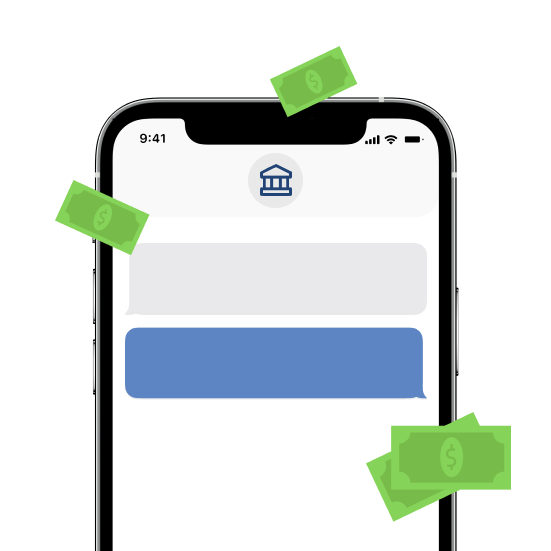SMS for Banking and Financial Services
24/07/2025

Today, you live in an environment crowded with deadlines, meetings, and countless commitments, as a bank customer, you no longer have the time to visit branches or wait on hold for customer service. Therefore, mobile banking (m-Banking) has become the best solution, offering banking and financial services through mobile devices via Short Message Service (SMS) which is a mobile-based technology that enables you to request and receive banking information from your bank through your mobile phone. Individuals or businesses can manage their bank accounts, check balances, request checkbooks, transfer funds, pay certain bills, and conduct other banking transactions using their mobile phones.
The Need for SMS Banking Services
Nowadays, the adoption rate of electronic banking services is significantly high. as more users register for electronic banking, the number of remote banking transactions (i.e., banking services outside traditional bank halls) increases, users can perform their transactions easily with digital banking, however, this convenience relies on secure SMS services that truly enable seamless mobile banking.
SMS banking supports full mobile banking patterns by allowing users to perform the following:
SMS for Two-Factor Authentication via OTP
Security is a fundamental component of banking operations, especially as digital transactions rise, from this an effective and increasingly used method by banks (Two-factor authentication through SMS and the delivery of OTP codes) is allows customers to receive verification codes even while roaming, offers free service, reduces operational and support costs, and is easy to deploy without additional devices, strengthening trust between customers and banks.
SMS for System Notifications
Ensuring 24/7 availability of banking systems and services is critical that SMS can be used to alert technical support teams in case of any system issues, leveraging the existing SMS infrastructure, these alerts can follow standard IT notification formats to reduce downtime and opportunity costs from service interruptions.
SMS for Payment Reminders
Payment collection is a major cost driver in credit card operations, especially when reminders are sent by traditional mail which incurring costs for materials, postage, and labor and SMS enables banks to send instant mobile reminders, helping customers avoid late fees and saving costs., because they are non-intrusive, portable, and allow immediate payments via ATMs, online, or other channels.
SMS for Card Activation
To reduce credit card fraud, customers must activate their cards before use it is an effective alternative to activation via phone or in-person, offering a simple and flexible channel for card activation anytime, anywhere.
SMS for Marketing
Marketing is one of the most expensive activities in credit card operations, that traditional media is often inflexible and costly on this side SMS provides banks and customers with a new way to execute quick, cost-effective marketing campaigns, reaching customers within seconds with precise demographic targeting (gender, age, spending habits).
SMS for Loyalty Points Inquiry
Loyalty point inquiries are a cost driver in banks, by offering an SMS channel, inquiry costs can be lowered, while encouraging customer spending and increasing revenue and it enables fast, anytime-anywhere access to loyalty information and streamlines point conversions.
SMS for Fraud Detection
SMS can help manage fraud by notifying customers of suspicious transactions or confirming doubtful activity, this helps reduce fraud losses, involves customers in security processes, and enhances transparency.
SMS for Card Transactions
Programs such as "Verified by Visa" and "MasterCard Secure Code" can be executed via SMS and reduces errors for customer registration via SMS, lowers transaction costs, and increases e-transaction revenues.
SMS for Offers and Discounts
Many customers complain they aren’t aware of credit card offers; SMS solves this by delivering on-demand information, increasing transaction revenues through customer awareness, lowering promotion costs, and enhancing loyalty among customers and merchants.
SMS for Credit Limit Inquiry
Providing instant balance inquiries via SMS helps customers manage spending better and costs less than call centers, this also encourages customer spending, increases revenues, avoids over-limit spending, and enhances financial control.
Benefits of SMS Banking
The implementation of financial services via SMS has significantly transformed e-banking by reducing costs, increasing convenience, and offering customers easy access to account information and transactions like stock purchases and money transfers via mobile phones. The following are the benefits of this service:
- Instant delivery of SMS messages to all mobile phones and networks
- Supported by most telecom operators
- No need for a special app or data package
- No login or passwords required (after initial registration)
- Works on all phones capable of sending/receiving SMS
- Easy-to-use SMS commands
- High compatibility across networks and technologies
- Non-intrusive and enabled by default for all users
- Low cost—often cheaper than traditional voice calls
- Sender bears the cost; recipients receive messages for free—even while roaming internationally
How SMS Works in Banking Services
SMS processing applications typically run on company servers connected to the SMS network through specialized connectors and gateways linked to mobile network operators' message centers. Thus, it's a highly reliable communication method.
SMS banking applications must analyze all banking transactions efficiently through time-based data analysis, enabling banks to develop models that predict customer creditworthiness, this analysis can also detect unauthorized money transfers and fraudulent activities.
Common Uses of SMS in Banking Transactions
There are two common SMS usage methods in banking applications:
1. Push SMS:
This involves sending a one-way message from the application (e.g., SMS server) to the mobile phone, for example a deposit alert notifying the user when funds are credited to their account.
2. Pull SMS:
This is a two-way communication where the user sends a request to the banking SMS application and receives the required information in return, for example, a customer sends an SMS to request their account balance.

SMS for Banking and Financial Services
Security Risks in SMS Banking Services
SMS banking services face several security threats, including:
1. Spam SMS to Mobile Numbers:
External parties might send spam or promotional messages to customers through mobile banking apps, potentially harming the bank’s reputation.
2. Information Leaks via System Logs:
Mobile banking apps may store SMS content (including sensitive data) in system logs that anyone with access to these logs or backups may gain unauthorized access.
3. Data Interception Between App and SMS Provider:
Data transmitted between the mobile banking app and the SMS provider may be intercepted, potentially exposing customer information.
4. Message Spoofing to SMS Provider Server:
If an attacker discovers the format of messages exchanged between the app and SMS provider, they could spoof the app’s identity and send messages to customers.
5. Fake Requests to Pull Component by Spoofing SMS Provider Server:
Attackers may impersonate the SMS provider server to obtain information from the bank’s pull system if message format isn’t verified.

SMS for Banking and Financial Services
How to Ensure Security and Privacy in SMS Banking
The main challenges in SMS banking include security, usability, and data continuity and the proposed system handles these efficiently without system failures or performance loss that Accurate transaction logs are maintained to avoid issues caused by unexpected behaviors.
SMS Providers Must Take These Measures to Minimize Security Risks:
1. Authenticate Sender Identity Before Sending Data to Customers:
Ensure only authorized staff can send messages through the bank’s application depending on the email server, apply proper digital signature methods to ensure authenticity.
2. Avoid Storing Sensitive Data in Logs:
Critical account details should not be logged, all logs must be encrypted to prevent unauthorized access.
3. Secure Data Transfer Between Bank and SMS Provider:
Ensure encrypted and secure data channels between bank, SMS provider, and telecom company using practical and effective encryption technologies.
4. Divide SMS Banking System into Five Main Units:
A series of clear and sequential methods should be applied to these units for a secure SMS-based banking system:
- Integration and API Unit
- SMS Technology Authorization Unit
- Customer Registration Unit for SMS Banking
- Push and Pull Services Delivery Unit
- Modified Data Continuity Management Unit
Data Protection & Cybersecurity Regulations in Saudi Arabia
Aligned with Saudi Vision 2030 and recognizing the importance of cybersecurity to build trust in digital solutions and national infrastructure resilience, the Communications and Information Technology Commission (CITC) developed a comprehensive cybersecurity framework for the telecom and IT sectors, this framework aims to regulate and empower cybersecurity practices among service providers and raise the sector’s security maturity through risk management methodologies., it ensures confidentiality, integrity, and availability of services.
Additionally, the National Cybersecurity Authority (NCA) has outlined minimum cybersecurity requirements. A comprehensive document was developed focusing on sensitive systems, building upon basic controls. It draws from international frameworks and standards, relevant national regulations, and lessons from real cyber incidents to establish a national framework mandating service providers to apply advanced risk management and cyber defines to protect user data and ensure business continuity.
- Gap analysis, maturity assessment, and penetration testing
- Designing, implementing, and operating suitable security quality systems
- Auditing and reviewing the organization's cybersecurity posture
- Developing cybersecurity strategy
- Hiring and qualifying security staff, establishing internal cybersecurity units
- Cybersecurity awareness campaigns and training
- Enforcing cybersecurity framework in ICT and postal sectors
- Quality systems audits ensuring regulatory compliance
- Deploying physical and digital security solutions
- Incident response and reporting framework implementation
Taqnyat is committed to applying the cybersecurity policies of the Communications and Information Technology Commission and the National Cybersecurity Authority in securing SMS banking systems
Contact Taqnyat now and ensure privacy and security in your banking transactions
FAQ
